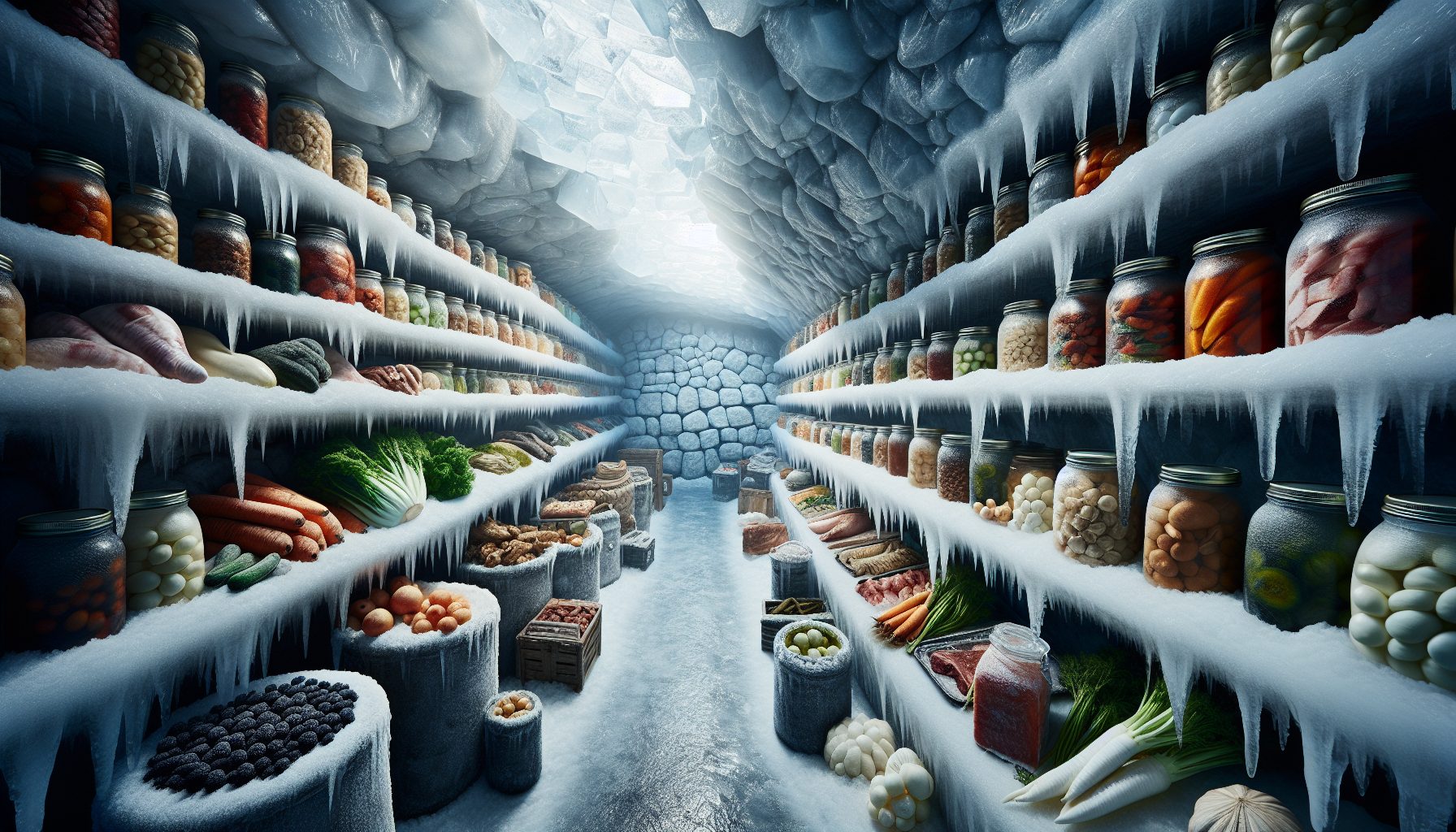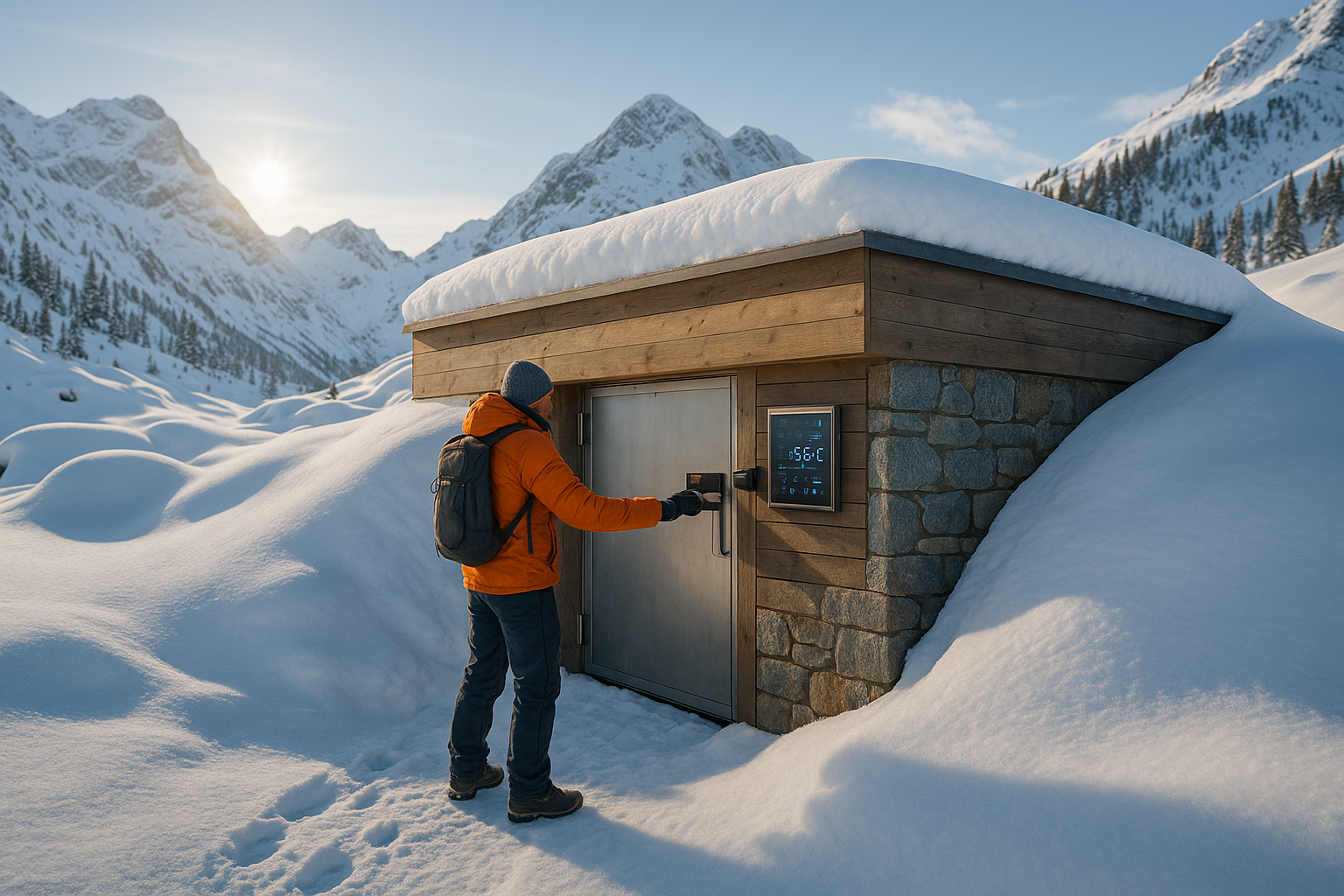In a world where the hustle and bustle of daily life often overshadows the simple joys of home-cooked meals and seasonal delights, the art of preserving food is experiencing a renaissance. The concept of freezing, once seen merely as a convenience, is now being reexamined as a crucial tool for sustainability, economy, and culinary pleasure. As we step into the intriguing realm of ice cellars, it’s essential to understand how maximizing the lifespan of frozen foods can revolutionize our approach to cooking and consumption. With global interest in reducing waste and increasing food security, learning the secrets of efficient food storage is more relevant than ever. So, whether you’re a seasoned chef or a curious beginner, this guide is your gateway to unlocking the full potential of your ice cellar and ensuring that your food remains as delicious and nutritious as the day it was frozen. ❄️
Imagine opening your ice cellar to discover a treasure trove of vibrant vegetables, succulent meats, and perfectly preserved fruits, each item waiting to be transformed into a delightful meal. The power to capture the essence of every season, to indulge in strawberries in the depths of winter or savor the rich taste of summer squash long after the leaves have fallen, lies in the art of freezing. But it’s not just about tossing items into the cold and hoping for the best; it’s about understanding the science behind freezing, the nuances of different foods, and the methods that will best maintain their flavor and texture. We’ll explore topics such as the ideal temperatures for different types of food, the importance of packaging, and how to avoid the dreaded freezer burn. We’ll delve into the benefits of blanching vegetables before freezing, the impact of air exposure, and how to organize your freezer to minimize energy consumption and maximize efficiency.
As we embark on this journey, we’ll also tackle common misconceptions and challenges that many face when trying to preserve food through freezing. From deciphering the mysterious symbols on packaging to debunking myths about refreezing, each section of this guide is crafted to empower you with knowledge and confidence. You’ll learn practical tips for extending the lifespan of your frozen foods, insights into how freezing can enhance nutritional value, and innovative recipes that will inspire you to view your ice cellar as a source of endless culinary possibilities. By the end of this exploration, you’ll not only have a well-stocked freezer but also the skills to ensure that every meal you prepare is infused with freshness and flavor. 🌟 Join us as we uncover the secrets to freezing perfection, transforming your ice cellar into a haven of preserved goodness and creativity.
The Importance of Proper Ice Cellar Management
Ice cellars, a time-honored method for preserving food, have been utilized for centuries. These underground chambers leverage the insulating properties of the earth to maintain temperatures conducive to food preservation, even during the warmer months. Proper management of an ice cellar can drastically increase the lifespan of the stored food, minimizing waste and ensuring a consistent supply of fresh ingredients. The art of ice cellar management involves understanding the balance between temperature, humidity, and the types of foods being stored.
Temperature control is paramount in ice cellar management. Maintaining a consistent cool temperature helps in slowing down the growth of bacteria and mold, which are the primary culprits in food spoilage. The ideal temperature range for an ice cellar is between 32°F (0°C) and 40°F (4°C). Various factors such as cellar depth, geographic location, and seasonal changes can affect this temperature. It’s crucial to regularly monitor these conditions using reliable thermometers and adjust accordingly, such as by adding more ice or insulating the cellar further if necessary.
Humidity is another critical factor. A high-humidity environment can be beneficial for certain root vegetables and fruits, but detrimental for items like grains and cured meats, which require drier conditions. Balancing humidity levels involves understanding the specific needs of the foods stored and occasionally employing techniques such as using desiccants or adding moisture through water pans to maintain the optimal environment. The effective use of shelving and storage containers can also help manage these conditions by separating foods that require different humidity levels.
Moreover, the types of foods stored in an ice cellar play a significant role in the success of the preservation efforts. Foods such as potatoes, carrots, and apples are known for their longevity in cold storage, while leafy greens and soft fruits have a shorter shelf life. Understanding these distinctions allows for better planning and utilization of the ice cellar space. A strategic rotation system ensures that older food is used first, minimizing spoilage. The use of proper containers, such as burlap sacks or wooden crates, can further extend the lifespan of the stored items by promoting air circulation and preventing bruising or damage.
Effective Organization Strategies
Efficient organization within the ice cellar is key to maximizing its potential. A well-organized ice cellar not only helps in extending the life of the food stored but also makes it easier to access and manage the inventory. Organization strategies can vary based on the type of foods stored, the layout of the cellar, and personal preferences.
One effective strategy is the use of shelving units that allow for easy access and rotation of stock. Shelving can be organized by food category, such as vegetables, fruits, and meats, or by humidity requirements. This systematization reduces the time spent searching for items and helps in maintaining a logical flow of goods. Additionally, labeling shelves and containers clearly can prevent confusion and ensure that the oldest stock is used first, adhering to the “first in, first out” method of inventory management.
Another important organizational aspect is the strategic placement of foods within the cellar. Items that are more sensitive to temperature fluctuations should be placed in the center of the cellar where temperatures are more stable, while hardier items can be placed closer to the entrance. This spatial organization helps in maintaining the ideal conditions for each type of food and optimizes the use of available space. Consider installing hooks or racks for hanging cured meats, maximizing vertical space and keeping them in a separate micro-environment.
Finally, cleanliness and maintenance are vital components of ice cellar organization. Regular cleaning schedules should be implemented to prevent the buildup of mold or bacteria. Keeping the cellar dry and well-ventilated can prevent the growth of unwanted microorganisms. Additionally, routine checks for structural integrity, such as sealing any cracks or gaps, can help maintain the desired conditions and prevent outside elements from compromising the cellar’s environment.
Choosing the Right Foods for Ice Cellar Storage
The selection of foods for ice cellar storage is a crucial decision that affects both the longevity of the items and the overall success of the preservation process. Understanding which foods benefit the most from cold storage allows for better planning and usage of the available space. Some foods are naturally suited for long-term storage, while others require specific conditions or additional preparation.
Root vegetables such as carrots, potatoes, and beets are among the best candidates for ice cellar storage. These items thrive in the cool, moist conditions typically found in ice cellars. Apples and pears also store well in these environments, especially when individually wrapped in paper to prevent ethylene gas from accelerating ripening. It’s essential to regularly check for any signs of spoilage or pests and remove affected items promptly to prevent them from affecting others.
Grains and legumes can also be stored in ice cellars, provided they are kept dry. Using airtight containers can prevent moisture from affecting these items and extend their shelf life. When storing cured meats, it’s important to maintain a drier environment within the cellar to prevent mold growth. Hanging these items on hooks or racks ensures good air circulation and prevents them from coming into contact with other foods.
Some foods require additional preparation before being placed in an ice cellar. For instance, certain vegetables can be blanched before storage to enhance their longevity. Blanching involves briefly boiling the vegetables and then plunging them into ice water to halt the cooking process. This method preserves color, flavor, and nutritional value, making it an effective technique for ice cellar storage.
| Food Type | Optimal Conditions | Recommended Storage Method |
|---|---|---|
| Root Vegetables | High humidity, cool temperature | Burlap sacks or wooden crates |
| Fruits (Apples, Pears) | Cool temperature, moderate humidity | Individually wrapped in paper |
| Grains and Legumes | Low humidity | Airtight containers |
| Cured Meats | Dry, cool temperature | Hanging on hooks |
For more insights on maximizing food storage in ice cellars, check out this video on YouTube: “Ice Cellar Mastery” by Home Preservation Channel. 🍎
Monitoring and Maintenance Practices
Regular monitoring and maintenance are critical to the longevity and effectiveness of an ice cellar. These practices ensure that the cellar remains in optimal condition and that any issues are promptly addressed. A proactive approach to maintenance can prevent minor problems from escalating into major issues, safeguarding the stored food.
Temperature monitoring is a fundamental aspect of ice cellar maintenance. Regular checks using reliable thermometers help ensure that the cellar remains within the desired temperature range. If fluctuations occur, it may be necessary to adjust the insulation or add ice to stabilize the environment. Humidity levels should also be monitored, and adjustments made as needed to maintain the balance between moisture and dryness.
Structural maintenance involves inspecting the cellar for any signs of wear or damage. Cracks in the walls or ceiling can allow warm air or moisture to enter, disrupting the controlled environment. It’s important to seal any gaps promptly and to check for signs of mold or mildew, which can affect both the structure and the stored food. Routine cleaning and ventilation are also essential to prevent the buildup of bacteria or unpleasant odors.
Inventory management is another key component of ice cellar maintenance. Keeping an accurate record of the items stored, their entry dates, and estimated shelf lives allows for better organization and reduces waste. Regularly rotating stock ensures that older items are used first, minimizing spoilage. Consider using digital tracking systems or apps to streamline this process and maintain an up-to-date inventory.
Advanced Preservation Techniques
In addition to traditional storage methods, there are advanced techniques that can further enhance the longevity of food stored in an ice cellar. These methods leverage modern technology and innovative approaches to preservation, offering additional options for those looking to maximize their ice cellar’s potential.
Vacuum sealing is one such technique that can be particularly effective for preserving meats and certain vegetables. By removing air from the packaging, vacuum sealing reduces the risk of oxidation and bacterial growth, extending the shelf life of the food. This method is especially useful for items that require a longer storage period or are sensitive to air exposure.
Fermentation is another advanced preservation method that can be utilized within an ice cellar. This technique not only extends the shelf life of foods like vegetables and dairy products but also enhances their flavor and nutritional value. Fermented foods can be stored in sealed containers within the ice cellar, benefiting from the cool, stable environment that slows down the fermentation process and enhances the development of beneficial probiotics.
Freeze-drying is a more sophisticated preservation technique that involves removing moisture from food through sublimation. While this method requires specialized equipment, the resulting products are lightweight, shelf-stable, and retain much of their original flavor and nutrients. Freeze-dried foods can be stored in airtight containers within the ice cellar, offering a long-lasting and convenient food supply for emergencies or extended trips.
- Ensure regular temperature and humidity checks.
- Rotate stock frequently to use older items first.
- Inspect the cellar structure for any signs of damage.
- Consider advanced preservation techniques like vacuum sealing and fermentation.
For a visual guide on advanced preservation techniques, take a look at this informative video: “Mastering Food Preservation” by Kitchen Science Lab. 🥕

Conclusion
In conclusion, “Frozen in Time: Maximizing the Lifespan of Your Ice Cellar Food” delves into the intricacies of preserving food in ice cellars, highlighting both traditional practices and modern innovations. We’ve explored the critical factors that impact the longevity of stored food, such as temperature regulation, humidity control, and the type of containers used. Additionally, we’ve discussed the evolution of ice cellars, from their historical origins to their resurgence in sustainable living practices today.
One of the key takeaways from our discussion is the importance of consistent temperature management. Maintaining a stable and optimal temperature is crucial for preventing spoilage and ensuring that your food remains safe and nutritious for extended periods. Whether through the use of digital thermometers or smart technology, monitoring the internal environment of your ice cellar can make a significant difference in the preservation process.
Humidity control is another pivotal aspect, as it can prevent the growth of mold and mildew, which are detrimental to food quality. We examined various methods to control humidity, including the use of desiccants and proper ventilation systems. Selecting the right materials for shelves and containers—preferably those that are non-reactive and resistant to moisture—further safeguards your food.
Furthermore, we delved into the types of food that are best suited for storage in ice cellars, ranging from meats and dairy products to root vegetables and preserved goods. Each category requires specific storage conditions to maximize shelf life, and understanding these nuances is essential for any homeowner looking to optimize their food preservation efforts.
The resurgence of ice cellars also ties into broader themes of sustainability and reducing carbon footprints. By relying on natural cooling processes, ice cellars offer an eco-friendly alternative to energy-intensive refrigeration systems. This not only helps in reducing electricity consumption but also promotes a more self-sufficient lifestyle, which is increasingly attractive in today’s environmentally conscious world.
In light of these insights, the relevance of mastering ice cellar storage is more significant than ever. As we face global challenges such as climate change and food security, the ability to preserve food efficiently becomes not just a personal benefit but a social responsibility. By implementing the strategies discussed, individuals can contribute to a more sustainable future while ensuring their households are well-equipped with preserved food.
To further your knowledge and apply what you’ve learned, consider consulting reputable resources such as the National Center for Home Food Preservation nchfp.uga.edu and the USDA’s guidelines on food storage . These sites offer in-depth advice and research-backed techniques that can enhance your ice cellar practices.
As we close this exploration, it’s important to remember that the art of food preservation is both a science and a craft. It requires attention, adaptation, and a willingness to learn from both successes and failures. By embracing the methods outlined, you are not only preserving food but also a way of life that honors tradition while embracing modernity.
We invite you to share your experiences, insights, or any questions you may have in the comments section below. Your contributions can spark discussions, inspire others, and build a community of like-minded individuals committed to sustainable living. If you found this article valuable, please consider sharing it with friends, family, or on social media platforms. Together, we can keep the knowledge and practice of ice cellar food preservation alive, ensuring that our food remains “Frozen in Time” for generations to come. 🌿🥶





